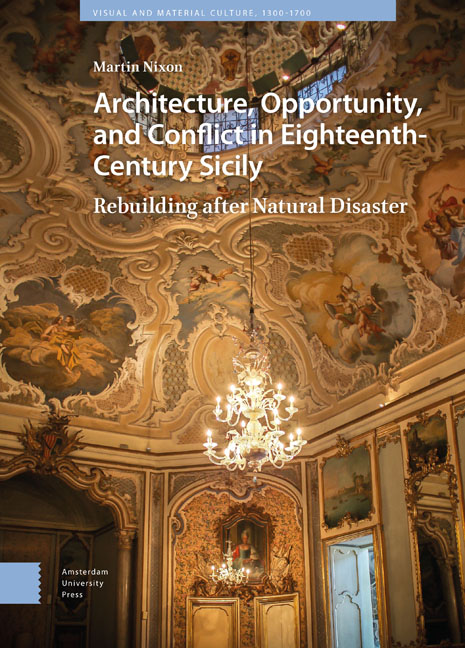 Architecture, Opportunity, and Conflict in Eighteenth-Century Sicily
Architecture, Opportunity, and Conflict in Eighteenth-Century Sicily Book contents
- Frontmatter
- Contents
- List of illustrations
- Acknowledgments
- Introduction: The Val di Noto Rebuilding: Disaster and Opportunity
- 1 Sicily as a Colonial Possession c. 1600–1750: Subordination and Resistance
- 2 The Hexagonal Towns of Avola and Grammichele : Urbanism, Fortification, and Coercion
- 3 The Palaces of Noto: Ornament, Order, and Opportunism
- 4 The Palazzo Biscari in Catania: Lightness, Refinement, and Distinction
- 5 The Palazzo Beneventano in Scicli: Trauma and Violence
- 6 The Palaces of Ragusa: Abundance, Famine, and the Grotesque
- Conclusion
- Glossary
- Bibliography
- Index
4 - The Palazzo Biscari in Catania: Lightness, Refinement, and Distinction
Published online by Cambridge University Press: 24 November 2023
- Frontmatter
- Contents
- List of illustrations
- Acknowledgments
- Introduction: The Val di Noto Rebuilding: Disaster and Opportunity
- 1 Sicily as a Colonial Possession c. 1600–1750: Subordination and Resistance
- 2 The Hexagonal Towns of Avola and Grammichele : Urbanism, Fortification, and Coercion
- 3 The Palaces of Noto: Ornament, Order, and Opportunism
- 4 The Palazzo Biscari in Catania: Lightness, Refinement, and Distinction
- 5 The Palazzo Beneventano in Scicli: Trauma and Violence
- 6 The Palaces of Ragusa: Abundance, Famine, and the Grotesque
- Conclusion
- Glossary
- Bibliography
- Index
Summary
Abstract: This chapter discusses the ballroom of the Palazzo Biscari in Catania in terms of its centrality to noble distinction. The ballroom's liquid and reflecting decoration, and its materials of gold, glass, and stucco, are refined and delicate, like the lightness and delicacy that aristocrats putatively possessed. Ballrooms, dance, and the training of aristocratic bodies allowed the nobility to maintain distinction through a similar lightness and refinement. This relates to Pierre Bourdieu's work on habitus, social class, and self-fashioning. Rather than discussing the ballroom as an empty shell, the chapter attempts to repopulate it by investigating the entertainments and dances it enabled, and the way dancing and the ballroom were essential to the realisation of aristocratic habitus and what could be called ‘the work of aristocracy’.
Keywords: ballrooms, history of dance, eighteenth-century aristocracy, ornament and material affect, architecture and material affect.
Placing the Ballroom at the Centre
The Palazzo Biscari, built by the Paternò Castello family, princes of Biscari, is situated in the dark grey streets of Catania's historical centre. At the palace's centre, the ballroom is a place of surprising opulence (Fig. 4.1). Light reflects from elegant gold frames, mirrors, tiles, and paintings. The ballroom once hosted large numbers of guests, but the bodies that occupied it and the entertainments that took place can only be imagined. The empty room evokes aristocratic dancers enveloped in a world of luxury and swirling golden energy. Its slightly worn and faded decoration sends signals from a vanished world.
One can imagine the room filled with guests. Some of them converse; they flutter their fans nervously and turn their heads to observe other groups. If the ball is in summer, a breeze might blow in from the adjacent sea-facing terrace. The musicians begin to play. The energised shapes of the decoration echo the dancers’ flickering, changing reflections in the mirrors around the ballroom and the flashes of light from their silk clothes. The dancing nobles are illuminated and reproduced by the mirrors. They monitor themselves and others in the mirrors and under the light of the chandeliers.
In addition to the ballroom, the Palazzo Biscari contained a theatre, a library, a museum of antiquities and mineralogy, a collection of armour, a room of chinoiserie, a room decorated with painted birds, and a room incorporating floor tiles from a Roman bath.
- Type
- Chapter
- Information
- Architecture, Opportunity, and Conflict in Eighteenth-Century SicilyRebuilding after Natural Disaster, pp. 127 - 178Publisher: Amsterdam University PressPrint publication year: 2023
